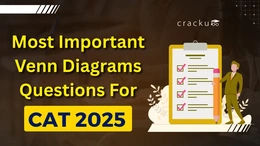Progression and Series Questions For CAT 2025
Progression and series questions are a vital part of the Quant section in CAT. They test your ability to understand sequences, detect patterns, and apply formulas efficiently. In CAT 2025, these questions often appear in moderate to high difficulty, so mastering them can help you secure good marks. In this section, we list and discuss some of the most important progression and series questions that you should practise thoroughly before CAT 2025.
Important Formulas for CAT Progression and Series Questions
To solve progression and series questions easily in CAT, you need to know some basic formulas. These help you quickly solve problems on arithmetic, geometric, and harmonic progressions. They save time, avoid mistakes, and make tough questions easier. With regular practice, you’ll get faster and more accurate.
Download CAT Progression and Series Formula PDF
Category | Concept | Formula / Tip |
Arithmetic Progression Formulas | nth Term | an=a+(n−1)da_n = a + (n - 1)dan=a+(n−1)d |
Sum of First n Terms | Sn=n2[2a+(n−1)d]S_n = \frac{n}{2}[2a + (n - 1)d]Sn=2n[2a+(n−1)d] | |
Sum using First & Last Term | Sn=n2(a+l)S_n = \frac{n}{2}(a + l)Sn=2n(a+l) | |
Average of Terms | Avg=a+l2\text{Avg} = \frac{a + l}{2}Avg=2a+l | |
Geometric Progression Formulas | nth Term | an=a⋅rn−1a_n = a \cdot r^{n-1}an=a⋅rn−1 |
Sum of First n Terms | Sn=a⋅rn−1r−1S_n = a \cdot \frac{r^n - 1}{r - 1}Sn=a⋅r−1rn−1 (if r≠1r \ne 1r=1) | |
Sum to Infinity | S∞=a1−rS_\infty = \frac{a}{1 - r}S∞=1−ra (if ( | |
Product of n Terms | P=an⋅rn(n−1)2P = a^n \cdot r^{\frac{n(n - 1)}{2}}P=an⋅r2n(n−1) | |
Harmonic Progression Formulas | Definition | Reciprocals in A.P. |
nth Term | an=1a+(n−1)da_n = \frac{1}{a + (n - 1)d}an=a+(n−1)d1 | |
Special Series | Sum of First n Natural Numbers | ∑k=1nk=n(n+1)2\sum_{k=1}^{n} k = \frac{n(n+1)}{2}∑k=1nk=2n(n+1) |
Sum of Squares | ∑k=1nk2=n(n+1)(2n+1)6\sum_{k=1}^{n} k^2 = \frac{n(n+1)(2n+1)}{6}∑k=1nk2=6n(n+1)(2n+1) | |
Sum of Cubes | ∑k=1nk3=[n(n+1)2]2\sum_{k=1}^{n} k^3 = \left[\frac{n(n+1)}{2}\right]^2∑k=1nk3=[2n(n+1)]2 | |
Telescoping Series | ∑(an−an+1)=a1−an+1\sum (a_n - a_{n+1}) = a_1 - a_{n+1}∑(an−an+1)=a1−an+1 | |
Miscellaneous | General Term from Sum | Tn=Sn−Sn−1T_n = S_n - S_{n-1}Tn=Sn−Sn−1 |
Recursive Sequences | an=f(an−1,an−2)a_n = f(a_{n-1}, a_{n-2})an=f(an−1,an−2) | |
AM ≥ GM ≥ HM | AM≥GM≥HM\text{AM} \ge \text{GM} \ge \text{HM}AM≥GM≥HM | |
Arithmetic-Geometric Series | S=a+(a+d)r+(a+2d)r2+…S = a + (a + d)r + (a + 2d)r^2 + \ldotsS=a+(a+d)r+(a+2d)r2+… |
Common Mistakes to Avoid in CAT Progression and Series Questions
Many students make similar mistakes while solving progression and series questions. Here are some common ones to watch out for:
-
Wrong type of sequence: A pattern may look like an A.P., but it might not be. Always check the difference or ratio first.
-
Basic calculation errors: Small mistakes in adding or subtracting can lead to wrong answers.
-
Missing starting point: Some series start from n=0n = 0n=0, others from n=1n = 1n=1. Read carefully.
-
Ignoring conditions: In infinite series, check if ∣r∣<1|r| < 1∣r∣<1. Also, watch out when r=1r = 1r=1.
-
Accepting invalid answers: If the question asks for integers, don’t accept decimal answers—even if they are correct mathematically.
-
Rounding too soon: Don’t round off values too early. It can change the final answer.
Avoiding these mistakes can help you improve your accuracy and score better in the exam.
List of CAT Progression and series Questions
DIRECTIONS for the following questions: These questions are based on the situation given below: There are fifty integers $$a_1, a_2,...,a_{50}$$, not all of them necessarily different. Let the greatest integer of these fifty integers be referred to as $$G$$, and the smallest integer be referred to as $$L$$. The integers $$a_1$$ through $$a_{24}$$ form sequence $$S1$$, and the rest form sequence $$S2$$. Each member of $$S1$$ is less than or equal to each member of $$S2$$.
Question 1
All values in S1 are changed in sign, while those in S2 remain unchanged. Which of the following statements is true?
correct answer:- 4
Question 2
Let x, y, z be three positive real numbers in a geometric progression such that x < y < z. If 5x, 16y, and 12z are in an arithmetic progression then the common ratio of the geometric progression is
correct answer:- 3
Question 3
Let $$a_{1},a_{2},a_{3},a_{4},a_{5}$$ be a sequence of five consecutive odd numbers. Consider a new sequence of five consecutive even numbers ending with $$2a_{3}$$
If the sum of the numbers in the new sequence is 450, then $$a_{5}$$ is
correct answer:- 51
Question 4
The nth element of a series is represented as
$$X_n = (-1)^nX_{n-1}$$
If $$X_0 = x$$ and $$x > 0$$, then which of the following is always true?
correct answer:- 4
Question 5
On day one, there are 100 particles in a laboratory experiment. On day n, where $$n\ge2$$, one out of every n articles produces another particle. If the total number of particles in the laboratory experiment increases to 1000 on day m, then m equals
correct answer:- 1
Question 6
Three times the first of three consecutive odd integers is 3 more than twice the third. What is the third integer?
correct answer:- 1
Question 7
For a real number x, if $$\frac{1}{2}, \frac{\log_3(2^x - 9)}{\log_3 4}$$, and $$\frac{\log_5\left(2^x + \frac{17}{2}\right)}{\log_5 4}$$ are in an arithmetic progression, then the common difference is
correct answer:- 4




















